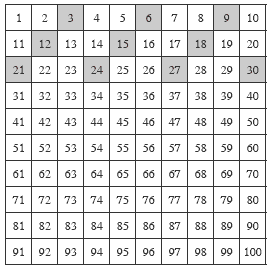Solve multiplication problems by using repeated addition.
Number Framework Stage 5
- Animal strips
- Multiplication fact cards (Material Master 6-2)
Using Materials
1. Put the cards or tags for the skip-counting sequence for twos (2, 4, 6, , …)randomly on the mat and ask the students what pattern they can see in the numbers. Expect them to put the numbers in counting sequence.
Ask them to perform a counting sequence in ones, with the accent on the numbers in front of them, i.e., 1, 2, 3, 4, 5, 6, 7, 8, …, while you move beads one at a time across the bead string or abacus.
Next, ask them to perform a mime count on the odd numbers, only saying the twos sequence numbers, i.e., _, 2, _, 4, _, 6, _, 8, …, while you move single beads across.
Next, ask them to say only the twos skip-counting sequence as you move groups of two beads across.
Finally, get them to find the bead that matches a given twos count number, e.g.,“Put this tag after bead 12.” Give the numbers randomly so that the students can count from previous numbers, e.g., to find bead 8, a student might count in twos from bead 4.
2. Repeat this sequence with the skip-counting sequences for ten and five.
3. Put the tags or cards for the skip-counting sequence by threes on the mat in mixed order. Ask the students what counting pattern exists in these numbers. Work through the same sequence as above with the three sequence.
4. Move over sets of three on the bead string or abacus but add one or two extra beads on the end. Ask the students to tell you how many beads have been moved in total. Look for them to recognise that the skip sequence works for groups of three but the remainders need to be counted in another unit, one or two.
Using Imaging
Tell the students that you going to count in threes but they will only be able to hear the sets of three being moved. Hide the bead string or turn the abacus around. Make sure that each three makes an audible “clack” as it is moved. Challenge the students by moving a different number of sets of three each time. Encourage the students to say the counting sequence quietly to themselves so that they only announce the answer if asked or write it invisibly on the palm of their hand for only you to see.
Progress to telling the students how many sets of three you have moved in one go. Bring in the vocabulary of multiplication, e.g., “So four sets of three is twelve, four times three is twelve.”
Next, ask the students to visualise the sets of three as divisors. Choose a counting sequence number, say 15, move that number of beads across and ask, “How many threes are in fifteen?”
In all steps of this process, the bead string or abacus can be exposed when necessaryto check on answers and ideas.
Using Number Properties
Look at the patterns that skip-counting sequence numbers make on a hundreds chart, e.g., the sequence of threes makes a diagonal pattern like this:
Ask the students to predict other numbers in the threes sequence. If necessary, these can be checked by counting up the sequence.
Ask questions such as, “Will 41 be in the pattern? How do you know?”
Point to numbers in the sequence (30 or less) and ask, “How many threes are in that number?”
Ask the students to say or write the matching multiplication statement, e.g., “Seventimes three is twenty-one” or 7 x 3 = 21.
Students can practise the counting sequences in pairs with a calculator. If they enter + 3 and press the equals sign repeatedly, this will generate the sequence 3, 6, 9, 12, … as the calculator adds three repeatedly. Similarly, entering a number minus three, e.g., 30 – 3, then pressing equals generates the repeated subtraction sequence, 30, 27, 24, 21, …
Have the students set challenges for a classmate such as:
“Press + 3. Without looking, press equals until 18 is in the window.”
“Press 15 – 3. Without looking, press equals until zero is in the window.”
Note: Students may realise that the answers to sets of these problems can be found using sets of two, e.g.:
6 sets of 3 is 6 sets of 2 plus 6 extra ones, i.e., 6 x 3 = (6 x 2) + 6. This shows an early understanding of the distributive property.
